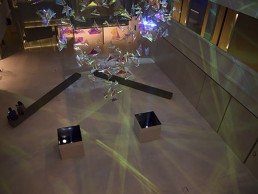
Students asissted by Martin Professional at Singapore Night Festival
(Singapore) – Singapore University of Technology and Design (SUTD) students developed ‘Flights of Fancy’ display in Singapore National Design Centre.
The reflective butterfly display was assisted by Martin Professional Exterior 400 LED lighting fixtures for 2014 Singapore Night Festival to mark culmination of SUTD’s 10-week Urban Lighting course.
The course taught students about effects of natural and artificial light on space. According to the SUTD student team leader, Kenickie Cher Jia Jun, Martin Professional fixtures were crucial in bringing the team’s vision for ‘Flights of Fancy’ to life.
Careful positioning of lights and shadows offered unique effects depending on the time of day and vantage point to ensure no experience was the same. The display featured a large floating sculpture made of hanging dichroic films – a reflective material the team used to mimic butterflies ascending into the sky. To do this, the team used eight Martin Exterior 400s, a MAC 700 Profile, and a MAC 250 Krypton to produce a powerful light for these reflections in a large space.
“One of the things we liked about the Martin fixtures was the ability to program a dynamic design,” said Kenickie. “The installation became ever-changing, making the experience unique for each visitor. The strong light source amplified the colours of the reflections and refractions created by the dichroic film.”
The Martin fixtures were concealed in two floor boxes below the floating sculpture and programmed to gradually change intensity and direction. Each box contained four Exterior 400 fixtures that provided colour washes that were slowly dimmed and then brightened over time.
Lighting Designer and student course instructor Shigeki Fujii described the fixtures as powerful and effective: “The dimming and movement of the lighting fixtures amplified the colours and effects of the display. Most observers did not even notice the lights were changing intensity and direction, they thought the effect was simply due to the wind.”
“Space, material and light source were the three most important components of the design,” said Fujii. “The light source had to be powerful and sharp to create crisp reflections on the space as well as programmable to allow us to amplify the dynamic effects.” According to Fujii: “The students would not have been able to complete their final project without the support of Martin’s team and their products.”



